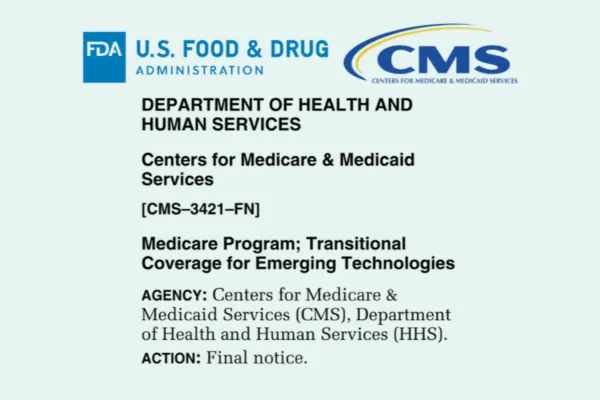
Wow. TCET Actually Happened.
On August 12, 2024, the Centers for Medicare and Medicaid Services (CMS) introduced a final rule for their proposed Transitional Coverage for Emerging Technologies (TCET) pathway. This new pathway is designed to expedite Medicare coverage for Breakthrough Devices, offering a streamlined process for evaluating these devices while they are still emerging in the market.
Overview of TCET Pathway
The TCET pathway aims to bridge the gap between FDA approval and Medicare coverage, focusing on early-stage technologies that have been designated as Breakthrough Devices by the FDA. These devices often represent significant advancements in treatment or diagnosis for life-threatening or debilitating conditions but face challenges in obtaining immediate Medicare coverage due to the limited evidence available at the time of FDA approval.
The TCET pathway will utilize existing National Coverage Determination (NCD) and Coverage with Evidence Development (CED) processes, allowing for earlier and more predictable access to these technologies for Medicare beneficiaries. This approach is designed to reduce uncertainty for device manufacturers and encourage the development of evidence necessary for long-term Medicare coverage.
Key Provisions
The final notice, published after the proposal was initially put forward in June 2023, includes several important provisions:
1. Voluntary Participation: The TCET pathway is voluntary, and manufacturers can choose to participate if their devices meet the eligibility criteria.
2. Evidence Development: If gaps in evidence are identified, manufacturers are encouraged to engage in "fit-for-purpose" studies to address these gaps. CMS will work closely with the FDA to align evidence requirements and avoid duplication.
3. Scope and Eligibility: The pathway is currently limited to certain FDA-designated Breakthrough Devices that fall within a Medicare benefit category. (Some stakeholders have expressed concerns about the limited scope, advocating for a broader application of the pathway, but you have to start somewhere.)
4. Nomination Process: Manufacturers can submit a non-binding letter of intent to nominate their devices for the TCET pathway. CMS will consider these nominations quarterly, with a goal of selecting up to five devices per year for the pathway. (Yes, only five.)
5. Timelines: CMS aims to finalize an NCD for accepted technologies within six months of FDA market authorization, although some stakeholders believe this timeline is ambitious given CMS resources.
Unknowns and Risks for Medical Technology Manufacturers
While the TCET pathway presents a promising opportunity, medical technology manufacturers must navigate several unknowns and risks:
1. Uncertain Outcomes: Despite the streamlined process, there is no guarantee of a positive NCD outcome. Manufacturers may invest significant resources into the TCET process only to face delays or non-coverage decisions if evidence gaps are not sufficiently addressed.
2. Resource Allocation and Strategic Focus: The TCET pathway requires significant investment in developing fit-for-purpose studies and other evidence. Smaller companies, in particular, may find this challenging due to limited resources. Additionally, with CMS planning to accept only up to five devices annually, manufacturers might concentrate their resources on this pathway. If their device is not selected, it could delay their ability to pivot to alternative market access strategies, potentially slowing down revenue generation.
3. Regulatory Alignment: Although the TCET pathway is designed to align with FDA processes, manufacturers may still encounter misalignments between FDA and CMS requirements. Differences in the type and quality of evidence needed by each agency can complicate the pathway, potentially leading to extended timelines and increased costs.
4. Perception by Private Payers: A rejection or non-selection from the TCET pathway could have broader implications. Private payers often look to CMS decisions as a benchmark for their own coverage determinations. If a technology is not selected for TCET or fails to secure Medicare coverage, private payers might view this negatively, potentially impacting their willingness to cover the technology. This could further delay market access and affect overall adoption of the device.
5. Long-Term Viability: The transitional nature of TCET means that manufacturers must plan for the transition to post-TCET coverage. If evidence development does not meet CMS standards during the transitional period, manufacturers could face coverage termination or the need to enter into a more rigorous coverage pathway.
Impact and Future Considerations
As CMS gains more experience with the TCET pathway, there may be opportunities to expand its scope to include a wider range of technologies. The pathway's initial focus on Breakthrough Devices is a strategic decision to address the most immediate needs within the Medicare population, but feedback from stakeholders suggests that broader inclusion could further enhance the impact of this initiative.
The introduction of the TCET pathway is a welcome development for the medical technology industry and Medicare beneficiaries alike. It reflects CMS's commitment to fostering innovation while ensuring that new technologies are rigorously evaluated for their clinical benefits and safety. By streamlining the coverage process for Breakthrough Devices, TCET has the potential to accelerate the availability of life-saving technologies for those who need them most.
However, manufacturers must carefully weigh the potential benefits against the risks and uncertainties involved. Strategic planning, resource management, and ongoing dialogue with CMS and FDA will be essential for navigating this new pathway successfully. As the TCET pathway evolves, it will be crucial to monitor its effectiveness and consider adjustments that could further optimize its implementation.
Interested in discussing further? Let's talk!
